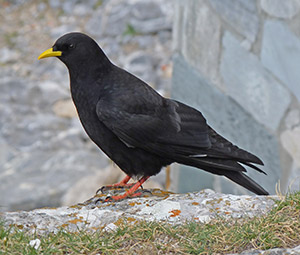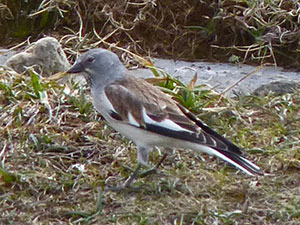The remarkable Picos de Europa barely needs an introduction! Home to an incredible variety of flora and fauna, the stunning mountain landscapes cover a wide range of habitats, and while concentrating on the birdlife present, we naturally will look at whatever else we find on route, from butterflies and mammals, to flowers and even an amphibian or reptile or two!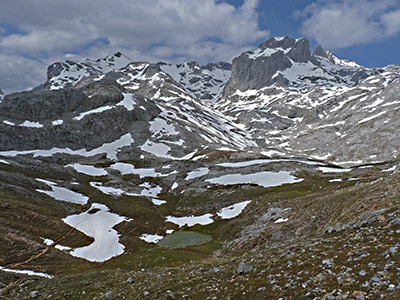 Picos de Europa alpine habitats above Fuente Dé
© John Muddeman
Picos de Europa alpine habitats above Fuente Dé
© John Muddeman
Hot, south-facing valleys show a strong Mediterranean influence, the cold clear streams and rivers –home to White-throated Dippers and Grey Wagtails– tumble down narrow ravines and create cool microclimates throughout, and of course, the swathes of flower-filled meadows –crafted and carefully tended by man over centuries and rich in butterflies and orchids– are set off by forests cloaking the steeper mountainsides, with alpine pastures and towering limestone pinnacles rising overhead. We meet at Santander airport before heading to the picturesque town of Potes via the impressive La Hermida gorge. If flight times allow, we will start off the birdwatching in a nearby public area which has excellent large oaks. In holes of these ancient trees a few pairs of Common Redstart breed, while Yellowhammer and European Serin are also present. Dinner and accommodation, as for the rest of the week, will be at the highly-rated Hotel Posada de Valdecoro in Potes. 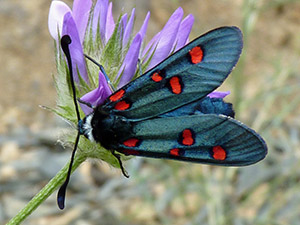 White-collared Burnet Zygaena lavandulae© John Muddeman White-collared Burnet Zygaena lavandulae© John Muddeman
Naturally, being in a mountain area in N Spain means that the weather can change rapidly, so the daily itinerary will change according to the conditions we experience. However, over the course of the week we will make a series of excursions to different nearby areas, with Potes being an excellent location and base from which to radiate out on a daily basis into some very different habitats, without travelling excessively. The San Glorio mountain pass is a lovely area, but there are also several interesting sites to enjoy birds and butterflies on the journey up, and undoubtedly we will make a few stops before reaching the top. A few of the key species to will look for here include Tree Pipit, the rather surprisingly local Citril Finch and also Northern Wheatear amongst others. We will also try our luck with the rare and declining Grey Partridge whose behaviour, rather like that of the Dunnock, is as a sub-alpine bird here in Spain. This is also an excellent spot to look for the scarce and endemic Chapman's Ringlet, the largest of all the ringlet butterflies, amongst a range of other commoner species, including Sooty Copper and a few fritillaries. Being based in Potes also means that we also have rapid access to the cable car at Fuente Dé, which is by far the easiest means of reaching the high mountain zone. To the south, the scenic and correspondingly very popular Piedrasluengas mountain pass is another good site to look out for Black Woodpecker, but other interesting birds that may be seen here include Marsh Tit, Goldcrest, Garden Warbler, Rufous-tailed Rock Thrush, Golden Eagle and Alpine Chough. Not far from here and into the Castilla y León region there are further interesting sites, and though extremely unlikely on our visit, Brown Bears are very occasionally seen, though Wild Cat is a more likely possibility. These are also good places for Rock Bunting and Eurasian Bullfinch. A quick visit to the beautiful Romanesque church of San Salvador de Cantamuda will also be possible. 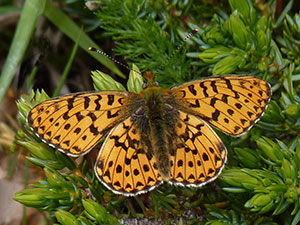 Pearl-bordered Fritillary Boloria euphrosyne© John Muddeman Pearl-bordered Fritillary Boloria euphrosyne© John MuddemanThe small villages in the area known as the Valle de Liébana all provide good chances to see Common Redstarts breeding in the old buildings, while various common birds are also present in their surrounding orchards. Additionally, these are good places to look for Wryneck and Great Spotted Woodpecker, though our main target today will be the pretty and very local Middle Spotted Woodpecker, which has one of its Spanish strongholds in the oak forests here. Other species in these habitats include Western Bonelli's Warbler, Firecrest, Short-toed Treecreeper and Red-backed Shrikes amongst others, while we'll also keep an eye to the sky for passing Griffon Vultures, Booted Eagles and other raptors. Finally, nicely complementing the longer journeys in our vehicle, there are plenty of small roads and hiking itineraries starting near Potes and one of our days will be spent exploring some of these. Part of this day will be used to explore some Sessile and Holm Oak woods which differ from each other in their birds, and among the most notable birds we will try to find Firecrest, Cirl Bunting, Pied and Spotted Flycatchers, Middle Spotted Woodpecker, Wryneck, European Honey Buzzard and Red-backed Shrike. Amongst the butterflies we should also see the showy Cleopatra, Brimstone and Spanish Swallowtail, while the Pink Butterfly Orchid is a quite common flower here. Time permitting we will make a stop or two along the coastline to look for a few new species for our tour, before ending at Santander airport. 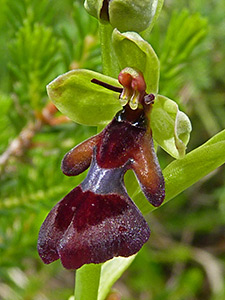 Fly Ophrys Ophrys insectifera
© John Muddeman
Fly Ophrys Ophrys insectifera
© John Muddeman
Picos de Europa: birds plus plenty more in stunning surroundings!Leader: John Muddeman for Spainbirds Nature Tours 2013 Dates: Price: 1200€, per person, including half-board, en suite accommodation at the Hotel Posada de Valdecoro, tapas / picnic lunches, minibus transport throughout, all entry fees including return cable-car tickets, and the services of John Muddeman as leader. A single-room supplement of 175€ is applicable. Please enquire. The cost is for a land-based tour. Flights and travel insurance (obligatory) are the responsibility of the client, though we can help with bookings. We start / finish at Santander airport. All payments have to be made in Euros to Spainbirds Nature Tours S.L. For booking and payment details and terms, please click on the "BOOKING FORM" link at the bottom of the page accessed HERE, or contact me directly (see addresses at the end). Booking information: either follow the link above or feel free to contact John Muddeman for further details and a booking form, or indeed if you have any queries about this tour.
|
|
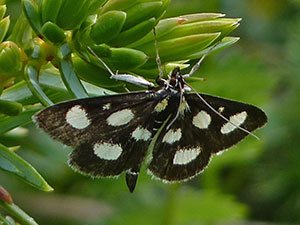 Crambid moth Anania funebris© John Muddeman Crambid moth Anania funebris© John Muddeman
Related information:Complete list of birds in SpainComplete list of butterflies in the Picos de Europa Complete list of orchids in the Picos de Europa Complete list of butterflies in the Picos de Europa Read about John Muddeman Wildlife holidays and natural history tours in Spain & Portugal |
||||||||||||||||||||||||||||||
|
||||||||||||||||||||||||||||||||


